Ligue 1 side Toulouse may not be staying in Ligue 1 next season. They are currently bottom of the table with only 13 points on their hands. They are eight points away from the 19th place and fifteen points away from getting out of relegation zone. They are now winless in 15 matches in a row. Morale is at an all-time low at the moment and unless there’s a miracle, it’s looking more and more unlikely to see Toulouse escape from relegation before the season ends.
This season, Toulouse have already sacked two managers in Alain Casanova and Antoine Kombouaré. At the moment, Denis Zanko is taking over as the caretaker manager, but there doesn’t seem to be any significant change at all.
In this tactical analysis/scout report, we’ll take a better look at why Toulouse are struggling this season.
Problems in attack
Toulouse are currently dead last in terms of productivity. They have scored a meagre 21 goals in 25 matches in Ligue 1 so far which is a highly disappointing tally. But judging by the way they’re playing in attack, you can see why they’ve only managed to produce few goals.
Toulouse are a team that tend to play from the back and work their way up patiently, mainly exchanging short-medium range passes in the process. They mainly attack through the flanks with both wingers having the tendency to hug the touchline and deliver crosses from inside or outside the box from the byline and both full-backs tending to deliver early crosses whenever they have the ball on the flanks.
Usually, against teams who block central access in the build-up, Toulouse’s centre-back will immediately play the ball to the nearest full-back. The full-back will then try to combine with the winger on the flank/half-space. Meanwhile, against teams who block access to the flanks in the build-up, Toulouse’s centre-back will try to play the ball towards their six or one of their eights who drop to receive (if the six is tightly marked or inaccessible). The six or one of the eights will then play the ball to the wide players on the flank or half-space where the winger and the full-back who advanced forward will combine.
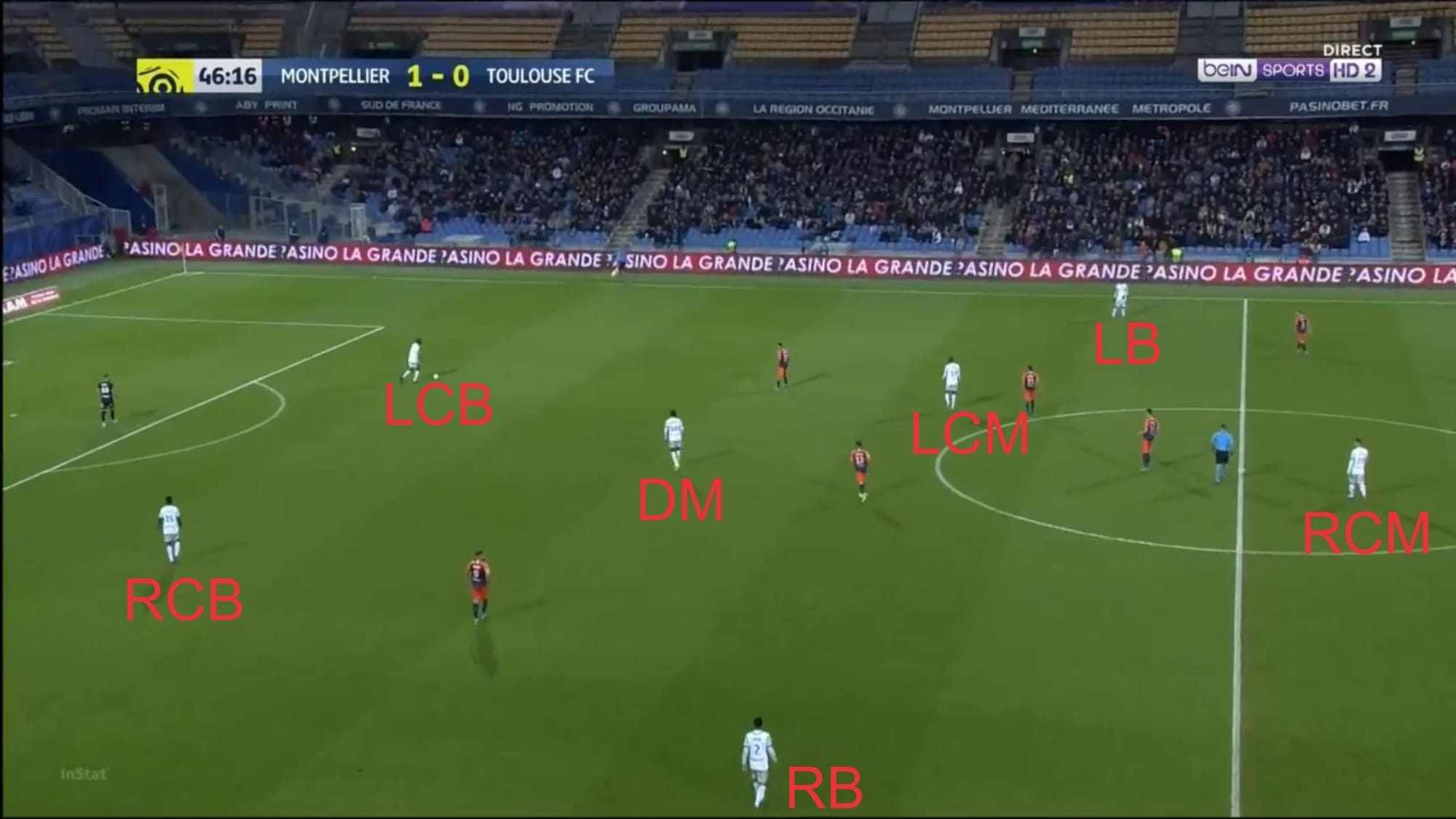
What stands out in Toulouse’s attacking play is their lack of ability to keep the ball in the build-up.
Firstly, for a team that are more possession-based than direct, Toulouse actually have a pretty low average passing accuracy per game with 82% from an average of 442 passes per game. They tend to lose possession due to poor passes and constant miscommunications. Ball-carriers seem to often be unsure where to play the ball to and the teammates around him seem to often be confused where to position themselves/move to. The lack of chemistry in the team seems to be the main cause of this problem. As a result, they are rather prone to losing the ball in their own half (especially against high-pressing and aggressive counter-pressing teams) and are having difficulties working their way into the box.
Secondly, as mentioned before in this tactical analysis/scout report, they tend to play from the back with the goalkeeper tending to distribute short rather than long balls. However, they’ll often struggle to get out of their own half, especially against teams with high or medium block. Even after being able to get the ball into the middle third, Toulouse are often still struggling to get the ball into more advanced areas and create chances. Below is an example of this problem.
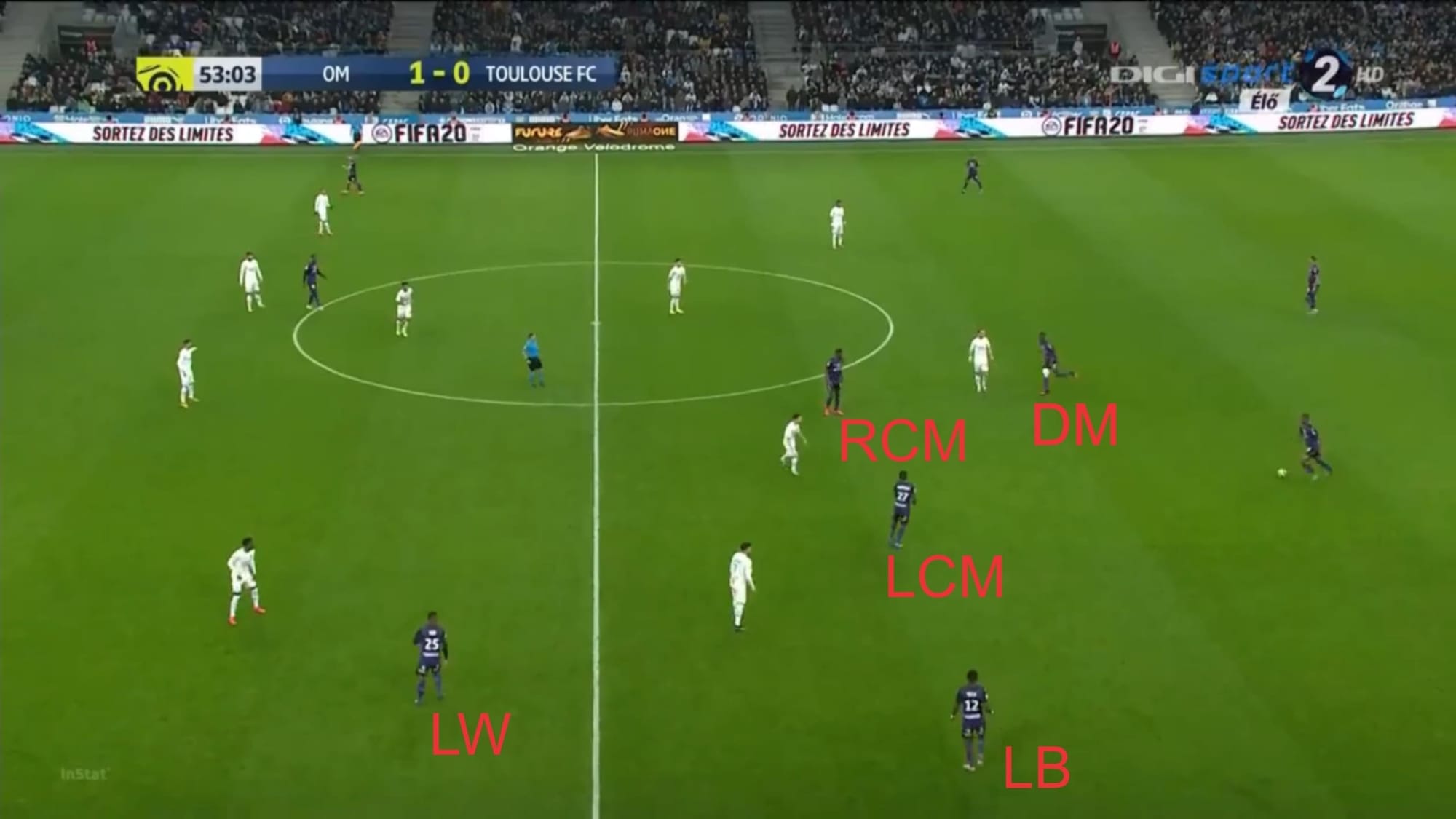
Toulouse tend to exchange quick short-medium range passes with few touches rather than dwelling on the ball for too long. As you can see above, Toulouse tend to keep the distance between players short, allowing them to be more comfortable in exchanging short passes and combining quickly in tight spaces. This way they can also create overloads in certain areas in attack.
However, what’s usually missing in these situations are the third-man runs or the runs into space. On this occasion, for example, Toulouse were able to rotate the ball around rather comfortably while Marseille were giving them moderately aggressive pressure. However, they’re unable to progress with the nobody making a run into space, as a result the ball stayed in the same area and Toulouse failed to launch their attack.
I believe fluid movements and active rotations by the midfielders and strikers will be very useful in the attack as this could help create space to move or to pass the ball into.
And thirdly, as mentioned before in this tactical analysis/scout report, Toulouse tend to attack through the flanks and as such will look to distribute the ball to the wide players in advanced areas who will then deliver crosses into the box. However, they rely a lot, perhaps too much, on their wide players when in the build-up and chance creation.
This is due to their strikers’ tendency to not get involved in the build-up and focus more posing danger through runs into space behind the defence or getting at the end of his teammate’s passes inside the box. This could be due to the manager’s instructions but may also be due to the players’ own decision.
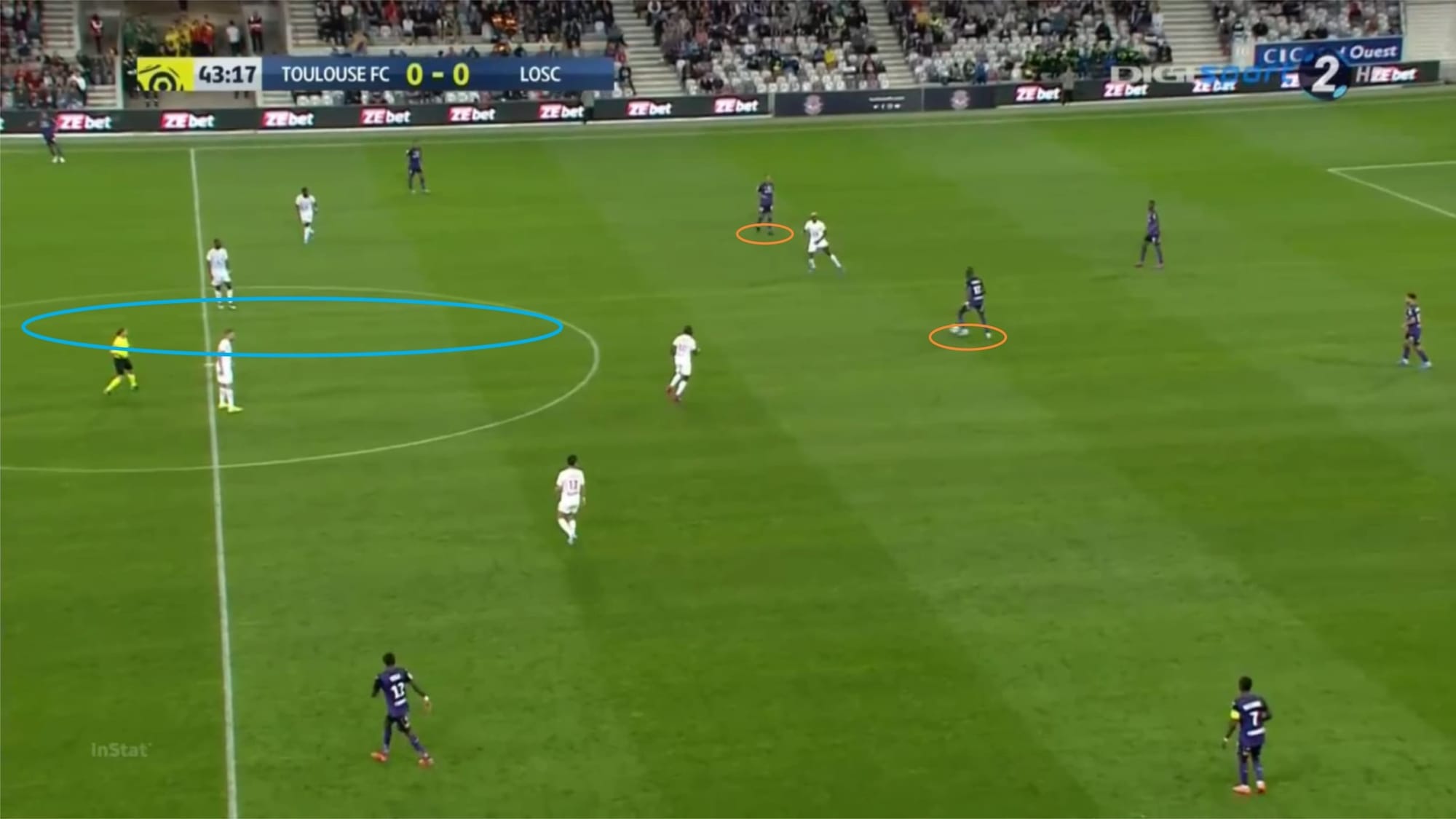
In the example above, Toulouse played using a double pivot (orange circles) in a 4-4-2 formation with Ibrahim Sangaré and William Vainqueur as the two pivots and Yaya Sanogo and Efthymios Koulouris upfront. As you can see on this occasion, Toulouse were trying to build up from the back but struggled to access central areas. This was due to the two strikers preferring to stay advanced rather than dropping into pockets of space between the opposition second and third lines. As a result, Toulouse resorted to moving the ball to the flanks and combine there. Lille managed to neutralise this effectively by trapping them out wide by creating overloads to isolate and exerting aggressive pressure.

Above you can see the passing maps of Toulouse from three games this season. As the thick lines suggest, Toulouse tend to play a lot of lateral passes in a game. This links back to their tendency to be patient and possession-based in the build-up, moving the ball around to find gaps and slowly working their way forward.
You can also see they do combine a lot around the half-space and wide areas. However, there tend to be not a lot of combinations between the midfield and the striker. Three different strikers play in these matches with Aaron Leya Iseka playing in a 4-3-3/4-1-4-1 setup against Marseille and Lyon and Koulouris and Sanogo playing in a 4-4-2 setup against Brest. Out of the three Koulouris seem to be the one who drops to link play the most while Sanogo is the least active in linking play and tend to stay advanced and centrally.
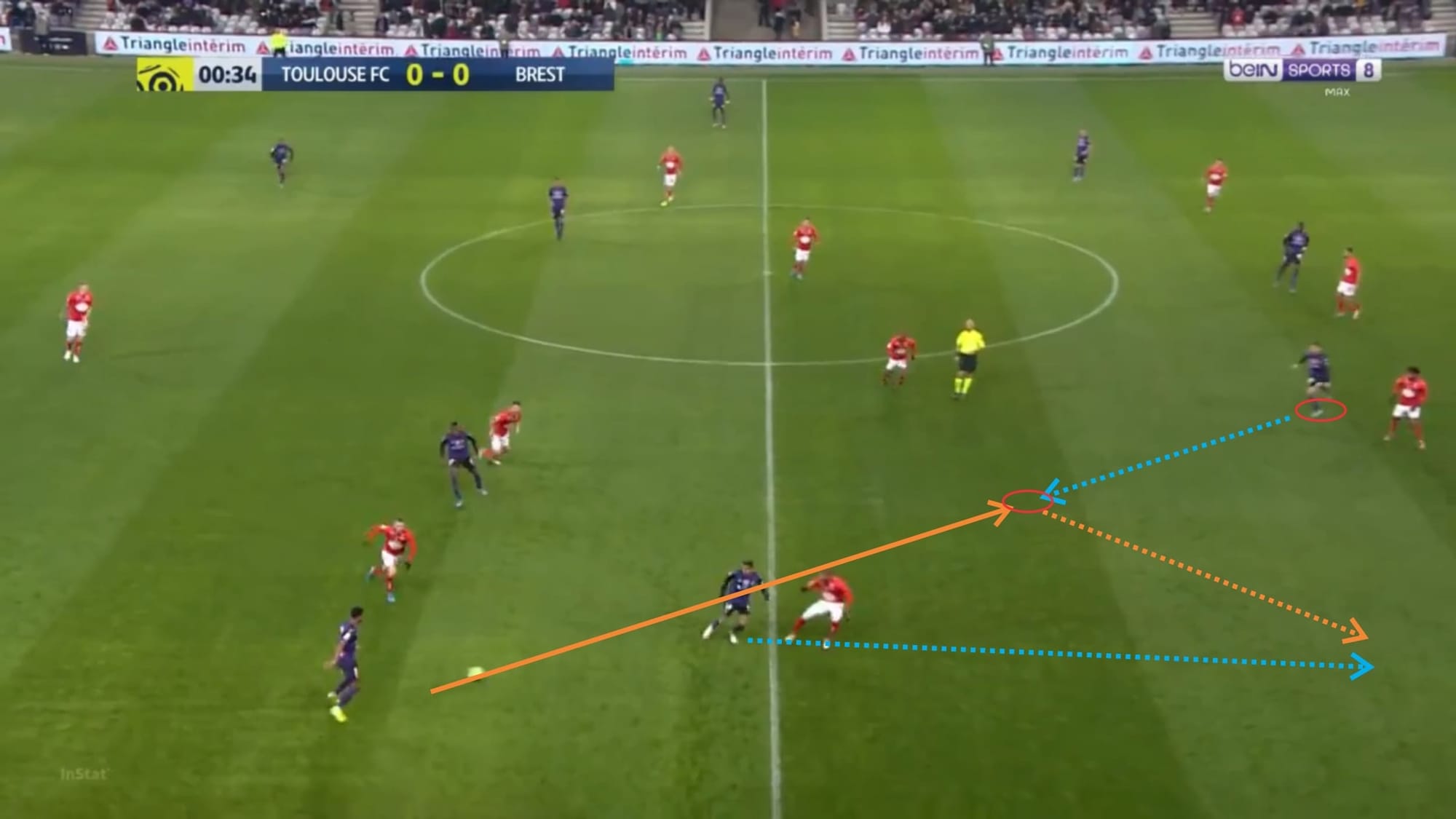
Above is an example when Toulouse’s attacking combinations on the flank worked well. In this particular situation, the right-winger of Toulouse managed to drag the left-back of Brest out of position and exchanged passes with the right-back. Upon receiving the return pass, the right-back saw the striker dropping into space between the lines and played the ball to him. The right-winger quickly turned after returning the pass and accelerated into space behind the defence. The striker then played the ball through onto the path of the right-winger. Very simple pattern utilising active movements between the lines as well as third-man runs and quick triangular combinations. I believe if Toulouse look to use the striker or their eights more often to exploit the spaces between the opposition second and third lines, they’ll be able to break through the opposing defence with much more ease.
Problems in defence
Aside from their lack of effectiveness upfront, Toulouse also have the worst defence in Ligue 1. They have conceded 51 goals so far from 25 games, averaging around two goals conceded per game. Their xGA total of 41.35 this season is the second-highest in the league, only behind Brest with 41.43 xGA.
However, while the latter have allowed a lot of high-quality chances at the back, they have conceded only 33 goals this season – mainly due to Gautier Larsonneur’s excellent form as well as luck, of course.
Toulouse, meanwhile, are the exact opposite. They have conceded even more goals than their xGA, meaning that they have been either very unlucky or the goalkeeper hasn’t been performing very well.
According to what we can see so far, the goalkeeper’s poor form does have a big effect in them conceding a lot of goals this season. Baptiste Reynet has conceded a total of 47 goals in his 22 Ligue 1 appearances this season, only managing to keep two clean sheets. Statistically, Reynet also has the second-lowest shots saved rate with 56.5% shots saved from an average of five shots on target faced per match. The French goalkeeper has been rather prone to making mistakes and often conceded soft goals. This resulted in Toulouse bringing in Lovre Kalinic on loan from Aston Villa this January.
However, the goalkeeper shouldn’t be the only one that should be getting the blame. Toulouse’s defence itself has been very leaky. They are lacking discipline and organisation.
Zanko’s side tend to defend zonally with a narrow and compact 4-1-4-1 shape (when using a 4-3-3 or 4-1-4-1 system) or a 4-4-2 shape (when using a 4-2-3-1 or 4-4-2 system). Against stronger teams, they tend to defend with a deeper block, but against teams with similar stature, Toulouse tend to defend with a medium or mid-high block. Generally, they’re not very aggressive in pressing which is proven with them having an average PPDA of 12.56 per match this season.
Toulouse ‘s first line of pressure is not very aggressive. However, they’ll start pressing and compressing space if the ball is played into the block in the middle. When the ball is moved wide, the block moves as well as they’ll try to create an overload on one side of the pitch while pressing the ball and marking the nearest options to prevent progression.
However, although they’re usually able to prevent progression on one side, whenever the ball is switched to the other side, they’ll usually struggle to defend that side as they’re not quick enough to move their block. Below is an example.
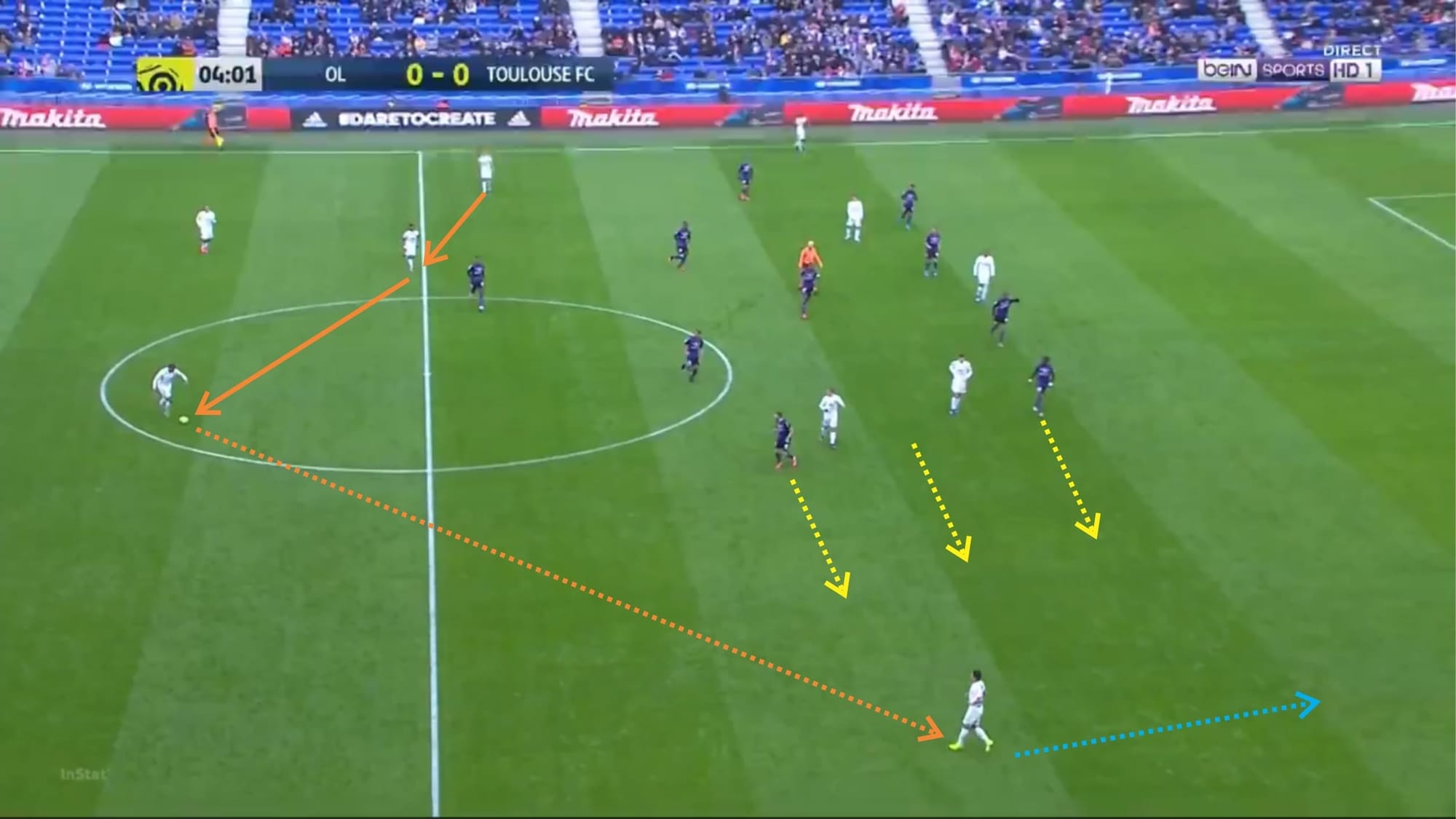
Above you can see Lyon successfully moving the ball to the right flank after failing to progress through the left flank. In this situation, Lyon’s right-back managed to receive the ball in an abundance of space as Toulouse were slow to move their block. With little pressure given to him, the Lyon right-back then managed to drive forward and create a chance with a cross. This kind of situation happens far too often which does show their lack of discipline in defence.

Aside from their sluggishness when moving the block, it’s apparently quite easy as well to break through their defence by utilising active movements upfront and attracting Toulouse’s press to open up space behind the defence. As mentioned before in this tactical analysis/scout report, Toulouse tend to overload one area of the pitch both in defence and attack and here we can see them doing so. Montpellier created an overload on one side of the pitch and managed to attract Toulouse’s left-back out of position by having one of their strikers drop into the middle third. The other striker took advantage of this by exploiting the space left by the defender.
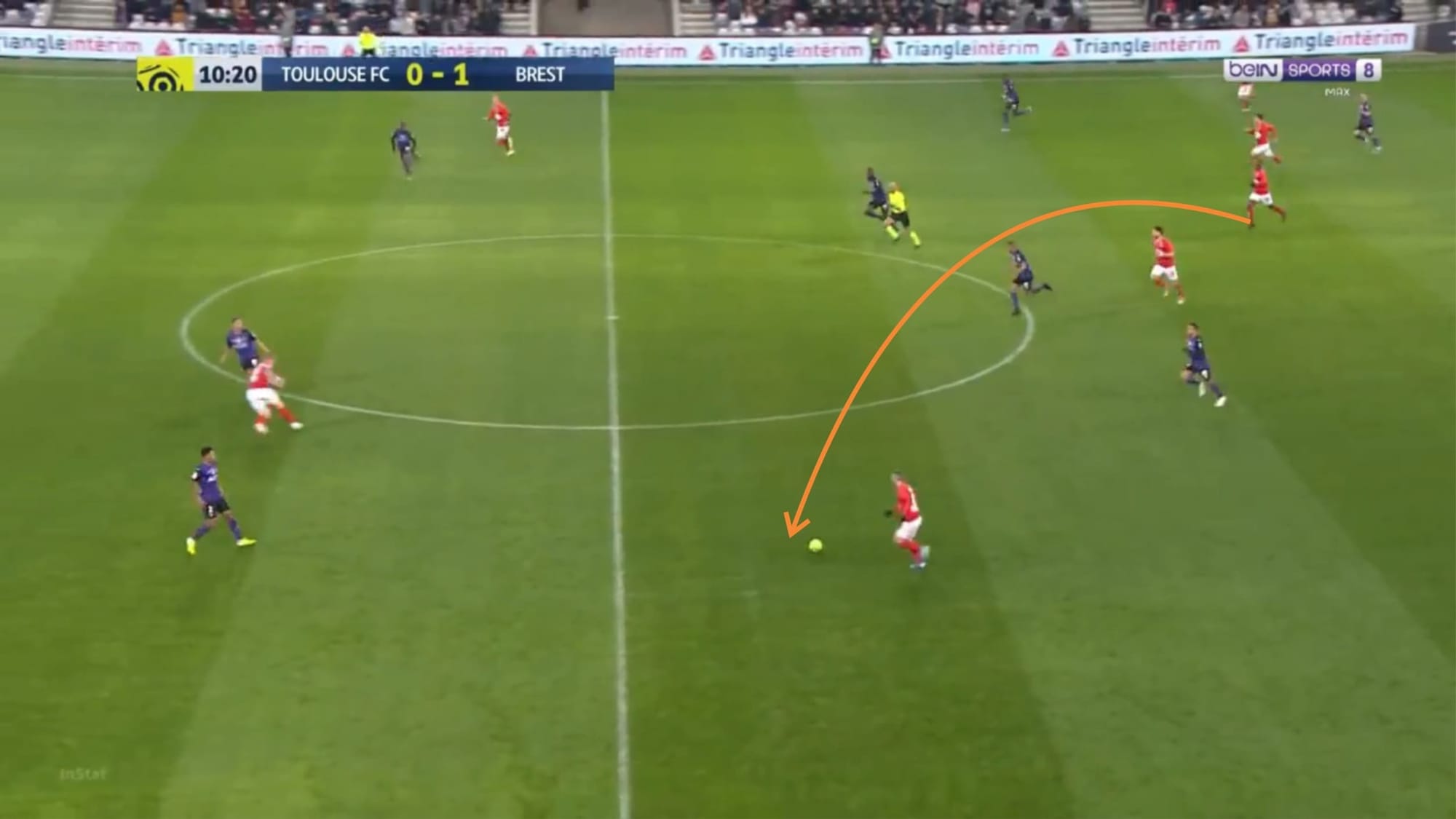
The same situation can also be seen in the picture above, only on this particular occasion, Toulouse were pushing high to press after losing possession. Again, linking back to their lack of discipline and organisation, Toulouse were trying to execute their counter-pressing strategy in this situation with their second line pushing forward to mark the ball-carrier’s options and having one or two players pressing the ball-carrier. However, Toulouse’s third-line didn’t push high as well which created a gap in the middle third. Toulouse’s pressure were also not aggressive enough and they were unable to block the passing lane to progress the ball. As a result, Brest managed to escape the counter-press and in turn, execute their counter-attack.
Better organisation and communications among the players in defence are badly needed. Aside from that, awareness, aggression, and discipline in defence need some improvements as well.
Conclusion
Toulouse pretty much have nowhere to go but down. It’s certainly not impossible for them to stay up, they’ll be facing very strong opponents in their next fixtures with the likes of Lille, Rennes, Reims, Bordeaux, Paris Saint-Germain, Monaco, and Montpellier waiting for them.
Toulouse have been struggling in the build-up and chance creation due to their inability to keep possession and poor connection between the midfielders and the striker(s). However, aside from those two problems, the strikers have also been struggling to find the back of the net. According to the stats, Toulouse actually have a total of 30 xG (ninth highest in the league) this season which actually shows that they’ve been able to create a few high-quality chances this season. However, they have only managed to score 21 goals which show their ineffectiveness in front of goal.
Defensively, Toulouse have also been very shakey. Though Reynet has been extremely poor this season, the main reason why they have conceded the most goals in the league this season is surely their lack of organisation and discipline in defence.
A little tweak in tactics can surely help them a lot in their struggle to get out of relegation zone this season although there’s no guarantee as to whether or not they can pull themselves out of the relegation zone before the season ends.




Comments